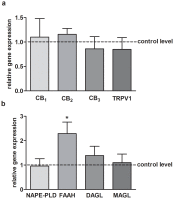Epigenetic regulation of fatty acid amide hydrolase in Alzheimer disease
- PMID: 22720070
- PMCID: PMC3373611
- DOI: 10.1371/journal.pone.0039186
Epigenetic regulation of fatty acid amide hydrolase in Alzheimer disease
Abstract
Objective: Alzheimer disease (AD) is a progressive, degenerative and irreversible neurological disorder with few therapies available. In search for new potential targets, increasing evidence suggests a role for the endocannabinoid system (ECS) in the regulation of neurodegenerative processes.
Methods: We have studied the gene expression status and the epigenetic regulation of ECS components in peripheral blood mononuclear cells (PBMCs) of subjects with late-onset AD (LOAD) and age-matched controls (CT).
Results: We found an increase in fatty acid amide hydrolase (faah) gene expression in LOAD subjects (2.30 ± 0.48) when compared to CT (1.00 ± 0.14; *p<0.05) and no changes in the mRNA levels of any other gene of ECS elements. Consistently, we also observed in LOAD subjects an increase in FAAH protein levels (CT: 0.75 ± 0.04; LOAD: 1.11 ± 0.15; *p<0.05) and activity (pmol/min per mg protein CT: 103.80 ± 8.73; LOAD: 125.10 ± 4.00; *p<0.05), as well as a reduction in DNA methylation at faah gene promoter (CT: 55.90 ± 4.60%; LOAD: 41.20 ± 4.90%; *p<0.05).
Conclusions: Present findings suggest the involvement of FAAH in the pathogenesis of AD, highlighting the importance of epigenetic mechanisms in enzyme regulation; they also point to FAAH as a new potential biomarker for AD in easily accessible peripheral cells.
Conflict of interest statement
Figures




Similar articles
-
Anti-Inflammatory Effects of Fatty Acid Amide Hydrolase Inhibition in Monocytes/Macrophages from Alzheimer's Disease Patients.Biomolecules. 2021 Mar 26;11(4):502. doi: 10.3390/biom11040502. Biomolecules. 2021. PMID: 33810505 Free PMC article.
-
Severe deficiency of the fatty acid amide hydrolase (FAAH) activity segregates with the Huntington's disease mutation in peripheral lymphocytes.Neurobiol Dis. 2007 Jul;27(1):108-16. doi: 10.1016/j.nbd.2007.04.012. Epub 2007 May 6. Neurobiol Dis. 2007. PMID: 17553686
-
Biomarkers of endocannabinoid system activation in severe obesity.PLoS One. 2010 Jan 20;5(1):e8792. doi: 10.1371/journal.pone.0008792. PLoS One. 2010. PMID: 20098695 Free PMC article.
-
Potential application of endocannabinoid system agents in neuropsychiatric and neurodegenerative diseases-focusing on FAAH/MAGL inhibitors.Acta Pharmacol Sin. 2020 Oct;41(10):1263-1271. doi: 10.1038/s41401-020-0385-7. Epub 2020 Mar 18. Acta Pharmacol Sin. 2020. PMID: 32203086 Free PMC article. Review.
-
The role of fatty acid amide hydrolase enzyme inhibitors in Alzheimer's disease.Cell Biochem Funct. 2022 Mar;40(2):106-117. doi: 10.1002/cbf.3680. Epub 2021 Dec 21. Cell Biochem Funct. 2022. PMID: 34931308 Review.
Cited by
-
Molecular Alterations of the Endocannabinoid System in Psychiatric Disorders.Int J Mol Sci. 2022 Apr 26;23(9):4764. doi: 10.3390/ijms23094764. Int J Mol Sci. 2022. PMID: 35563156 Free PMC article. Review.
-
Neuroprotection in Oxidative Stress-Related Neurodegenerative Diseases: Role of Endocannabinoid System Modulation.Antioxid Redox Signal. 2018 Jul 1;29(1):75-108. doi: 10.1089/ars.2017.7144. Epub 2017 Jul 18. Antioxid Redox Signal. 2018. PMID: 28497982 Free PMC article. Review.
-
The Role of DNA Methylation and Histone Modifications in Neurodegenerative Diseases: A Systematic Review.PLoS One. 2016 Dec 14;11(12):e0167201. doi: 10.1371/journal.pone.0167201. eCollection 2016. PLoS One. 2016. PMID: 27973581 Free PMC article.
-
Endocannabinoid signaling and epigenetics modifications in the neurobiology of stress-related disorders.Neuronal Signal. 2023 Jul 25;7(2):NS20220034. doi: 10.1042/NS20220034. eCollection 2023 Jul. Neuronal Signal. 2023. PMID: 37520658 Free PMC article. Review.
-
Utility of DNA Methylation as a Biomarker in Aging and Alzheimer's Disease.J Alzheimers Dis Rep. 2023 May 31;7(1):475-503. doi: 10.3233/ADR-220109. eCollection 2023. J Alzheimers Dis Rep. 2023. PMID: 37313495 Free PMC article. Review.
References
-
- Lleó A, Greenberg SM, Growdon JH. Current pharmacotherapy for Alzheimer's disease. Annu Rev Med. 2006;57:513–533. - PubMed
-
- Centonze D, Battistini L, Maccarrone M. The endocannabinoid system in peripheral lymphocytes as a mirror of neuroinflammatory diseases. Curr Pharm Des. 2008;14:2342–2370. - PubMed
-
- Mechoulam R, Hanus L. A historical overview of chemical research on cannabinoids. Chem Phys Lipids. 2000;108:1–13. - PubMed
-
- Piomelli D. The molecular logic of endocannabinoid signalling. Nat Rev Neurosci. 2003;4:873–884. - PubMed
Publication types
MeSH terms
Substances
LinkOut - more resources
Full Text Sources
Other Literature Sources
Medical

